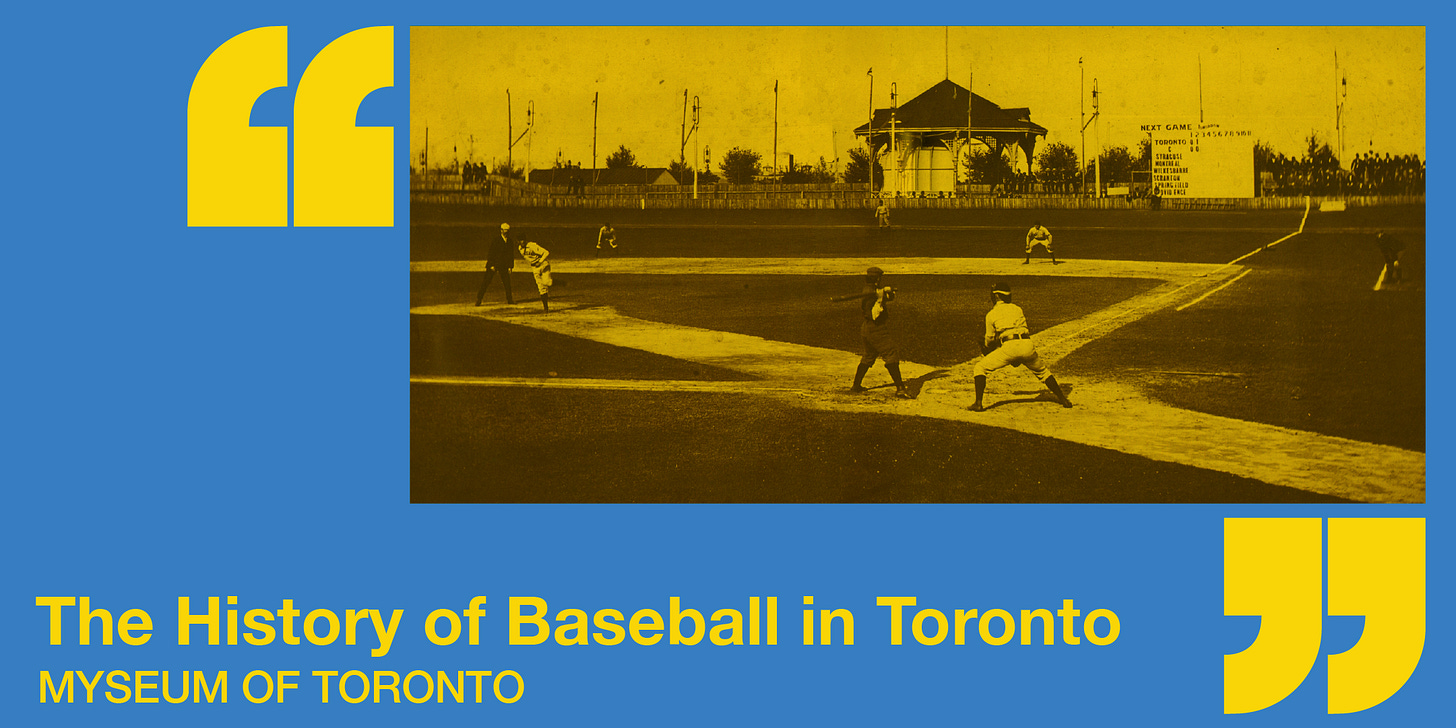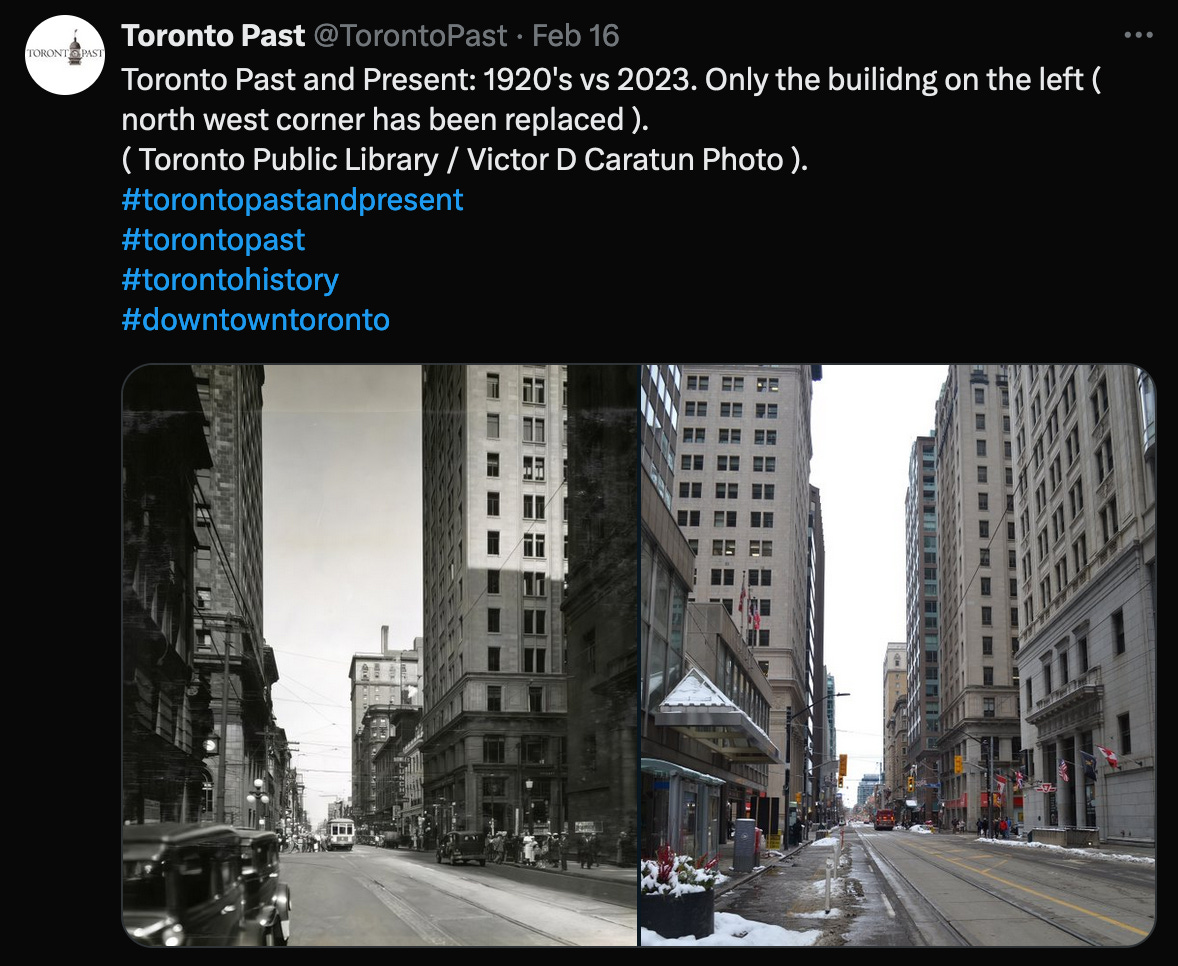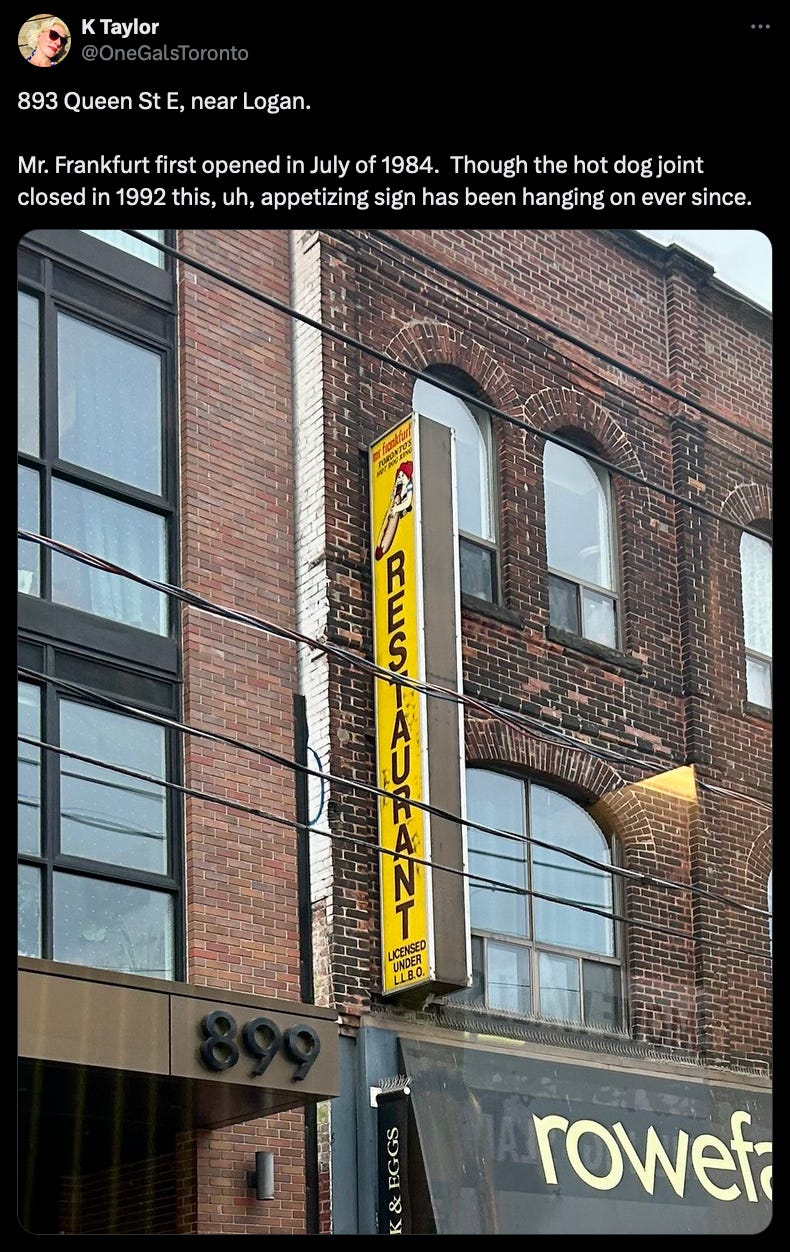How Napoleon Lajoie Won The Pennant
Plus my Toronto baseball history course starts tomorrow, a new look for the ROM, and more...
It all began on a bitterly cold spring day in 1917. It was the first week of May and the baseball season was getting underway, but winter just wouldn't let go. That frigid afternoon, only the most die-hard fans braved the weather to attend the home opener. Five thousand of them boarded ferries on the waterfront and made the chilling journey across the bay to file in through the turnstiles of Hanlan's Point Stadium. They bundled themselves up in the windswept grandstands, shivering away in the mostly-empty ballpark as they watched the Toronto hitters get shut down by the Orioles; the team failed to score a single run in front of their hometown crowd.
But even the loss and the weather’s icy grip couldn't dampen the excitement of the day. The Globe raved that "it was one of the most spectacular and successful openings ever staged by the Toronto club." And that was in large part thanks to the man standing at second base.
His name was Napoleon Lajoie. By baseball standards, he was an old man. He'd played in the Major Leagues for the last 21 years, a career that had started all the way back in the late 1800s. In that time, he'd proven himself to be one of the greatest ballplayers ever to live. In his prime, he set records that still haven't been broken more than a century later. As a 27-year-old, he hit .426 — still tops in American League history — won the batting triple crown and struck out just nine times all season. By the end of his career, he'd become one of the first to collect 3,000 hits. Modern stats suggest he was one of the top three second baseman ever to take the field. He would go on to become one of the first players inducted into the Baseball Hall of Fame.
They say that Lajoie was so dedicated to the craft of hitting that he never went to the movies or read a newspaper on a train for fear of hurting his eyes. His defence was awe-inspiring, too; sports writers said he was so effortlessly graceful that he made even chewing tobacco look good. When he played for Cleveland, he was so popular they named the team after him: they became the Cleveland Napoleons. Naps for short.
But in all that time, Lajoie had never won a championship. He had never known the joy of finishing a season in first place. One pennant slipped away when he was cut by an opposing player's spikes; he got blood poisoning and nearly lost his foot. A second chance was squandered when his former team had him legally banned from playing in the state of Pennsylvania the same year his Philadelphia teammates took the crown. A third was lost in heartbreaking fashion on the final day of the season. And by the time he was a grizzled veteran fast approaching forty, his skills began a precipitous decline. For a while, he kept playing anyway, chasing the dream of snagging just one championship before he retired. But time eventually ran out. Napoleon Lajoie finally retired from the Majors at the age of 42, never having won a pennant.
That's when he came to Toronto. He might have been too old to play second base in the Majors anymore, but he had a lot of knowledge to pass down to younger players. And so, he signed on as the manager for one of the most storied franchises in the history of minor league baseball: The Toronto Maple Leafs.
By then, our city already had a long history of success on the diamond. Toronto's first baseball championship came all the way back in the 1880s. In those early days, the creatively-named Toronto Baseball Club played at Sunlight Park overlooking the eastern slope of the Don Valley at Queen Street. The Maple Leafs were founded soon after that — in the 1890s, decades before the hockey team took the same name. They would spend the next 70 years as one of the marquee franchises of the International League, which is still among the top minor leagues today. And before long, they'd moved to a new home on the islands. Since they were owned by the same people who ran the Toronto Ferry Company, it let them sell two tickets to every game — one for the crossing, one for admission.
By the time the 1917 season rolled around, the first two stadiums on the island had burned down. The Leafs were now playing in a gorgeous new ballpark. Hanlan's Point Stadium was the biggest in the minor leagues when it first opened in 1910. It boasted more than seventeen thousand seats, a rollercoaster just beyond the outfield wall, and a spectacular view of the Toronto skyline. Over the next few years, the ballpark witnessed two more championships and the very first professional home run by a young visiting player named Babe Ruth. His blast is thought to have soared over the right-field fence and beyond the rollercoaster to land with a splash in the lake.
Now, Hanlan's Point would be home to Napoleon Lajoie. He already had strong connections to Canada: his parents were both Québecois; his older siblings had grown up on a farm outside Montreal. And when he signed on as the Leafs new manager, Lajoie was given tremendous power over his new team, not only responsible for decisions on the field but also for signing and trading players.
It was big news when the old star signed with Toronto. Local newspapers celebrated the move, waxing nostalgic for his glory days. "Baseball was an art with Lajoie," The Star remembered, "He did all things with infinite grace." Still, it did seem as if his contributions would be strictly limited to the dugout. As The Globe explained, "Lajoie is through as a player."
But that's not exactly the way things turned out.
It wouldn't be an easy season for the old skipper. That unusually cold Canadian spring meant that games in Toronto were being cancelled as late as Victoria Day that year. Some players rebelled against Lajoie's leadership; one pitcher just up and left the team. The future Hall of Famer got suspended twice for arguing with umpires. And with the First World War raging, some of his players were being drafted halfway through the season; the others ran military drills every day before their games. And maybe worst of all: there was Lajoie's crippling fear of water. Every day he had to take the ferry out to the island ballpark must have been a harrowing ordeal.
But while the veteran second baseman had slowed down considerably, he was sure he still had something left in the tank. On opening day, he pencilled himself in as the team's clean-up hitter. And though he cost them that game, booting an easy groundball in extra innings, he put himself back in the line-up the next day. And the day after that. And after that. And he quickly began to rack up hits. Against younger, less experienced minor leaguers, Lajoie was going to thrive.
That season, he would prove to be the best hitter in the league. He led the IL with a .380 average and put together a 21-game hitting streak. Better yet, after a slow start to the season, his Maple Leafs were starting to win. By the end of August, they were right in the thick of the pennant race. As they headed into the final two weeks of the season, Toronto was battling Baltimore, Providence and Newark for first place.
The entire season had been a triumphant tour for Lajoie. Everywhere the Leafs went, opposing teams celebrated and honoured his career. They held "Lajoie Days" and showered him with gifts. Fans gave him thunderous ovations. He was playing so well that Major League teams soon began showing interest in him again. That summer, both the Chicago Cubs and the Washington Senators offered him a spot on their rosters. His career wasn't over after all. If he wanted to return to the Majors, all he had to do was say yes.
Instead, he turned them both down. He was determined to finish what he'd started in Toronto. Against all the odds, Napoleon Lajoie was being given another chance to achieve his dream; one more shot to win the championship that had eluded him throughout his career. He wasn't about to let that opportunity go.
During that final stretch of games, Lajoie led the way. In one double-header against Buffalo, he got six hits in a single day. Against Montreal, he belted two home runs to secure an extra-inning win. Then, he took control of another double-header with another six-hit-day. "Lajoie was himself worth four ordinary players," The Globe gushed. He'd become so beloved in Toronto that the press had started calling the team the Lajoies.
In the end, it all came down to the final day of the season. The Maple Leafs were in the driver's seat. If they won both games, they'd finish in first place. Lajoie would have his pennant.
In the opening game, it was Toronto's pitching ace — Harry Thompson — who carried the team. He shut out the Rochester Hustlers over the course of nine innings despite a sore arm, only giving up three hits on the way to his 25th victory of the season. He even scored the game's only run himself. The Leafs won by the smallest possible margin: 1-0.
The second game was a tense, scoreless battle over the first five innings. The fate of the season hung in the balance with every pitch. A single mistake could cost the team the entire season. And then, that mistake came.
Lajoie was playing first base that day. And in the top of the sixth, one of the Rochester players hit a ground ball back toward the mound. It took a big hop over the pitcher's head, seemingly destined for the shortstop — still a routine ground ball. Lajoie prepared for the throw to come into him at first base for the out. But he'd taken his eye off the ball. He hadn't seen his pitcher leap into the air and make a barehanded grab. He expected the throw to come from the shortstop. Instead, it came from the pitcher. He missed it.
As the ball rolled away, the hitter kept running all the way to third. He quickly scored after that. The Leafs were suddenly losing: 1–0.
It must have felt like it was all slipping away yet again. After more than 21 years playing professional baseball, after decades of heartbreaking losses, after blood poisoning and court battles, after a season of frigid temperatures and player revolts, after all those terrifying ferry rides to the island, after turning down those offers from Major League teams, after all of that… it must have seemed like was it going to end in another crushing loss.
But the Leafs weren't about to let that happen. "Lajoie had imbued the men with his own indominable spirit," The Globe reported. "They fought every inch and every minute." In the bottom of the inning, they battled back. A single. A bunt. Another single. There were now two men on. The tying run and the go-ahead run. A chance to take the lead.
That's when Lajoie came to the plate. His mistake was weighing heavily on his shoulders. "If my error… had been the means of losing the game and the pennant," he later told the press, "I don't believe I could have gone to the clubhouse and faced the boys who have worked so faithfully for the championship." It all came down to this.
The Rochester pitcher wound up… delivered his pitch… Lajoie swung… connected… the ball leapt off his bat… slashed toward left field… where it landed on the grass. By the time the outfielder got the ball back in, Lajoie was standing on second base. Both runs scored. The Leafs had taken the lead.
Those runs were all they needed that day, but they added three more before it was all over. They would win 5–1. The final play of the game was a groundball to shortstop. This time, Lajoie watched the ball carefully as it landed in his glove for the last out of the season.
Then his face broke into a grin. Napoleon Lajoie had finally won his pennant.
My Baseball Course Starts This Tuesday!
There are still a few weeks left before our Toronto sports history exhibit closes at Myseum — and with the Blue Jays’ spring training also about to kick off, we’ve decided the best way to celebrate is by bringing back my online course about the history of baseball in Toronto.
We’re offering it as a Myseum Masterclass called The History of Baseball in Toronto: From Sandlot to SkyDome with Adam Bunch. It’ll begin on February 20 and run every Tuesday night at 7pm on Zoom until March 12. Registrations are $75 (plus Eventbrite fees) and will help support Myseum in all the amazing work they do.
Here’s the full course description:
Baseball was being played in Toronto more than a century before the Blue Jays were born.
In this online course, we'll explore the game's evolution in our city — from the days when it was a working class sport played by "undesirables" to Joe Carter jumping for joy in front of 50,000 screaming fans.
Along the way, we'll meet everyone from con artists and kidnappers to eccentric millionaires and feminist icons — the people who've made Toronto baseball what it is… and helped transform our city in the process.
I’ve even made a little trailer for it!
Thank you so much to everyone who supports The Toronto History Weekly with a few dollars a month! The newsletter has more than 3,200 subscribers, but only 121 of those are paid — so not only are you helping to keep the newsletter going, each of you is also essentially giving the gift of Toronto history to 25 other people. If you haven’t already made the switch but would like to, you can do it by clicking right here:
I’ve Got Three Upcoming Talks!
I’ve got a busy couple of months coming up, including a few talks that I’m giving for local historical societies. They’re all open to the public, so I thought I’d let you know all the details in case you’d like to check any of them out…
THE TORONTO BOOK OF LOVE & THE CITY’S ROMANTIC PAST
Wednesday, February 21 — 7pm || I’ll be talking about The Toronto Book of Love for the North York Historical Society this Wednesday night at the North York Central Library (5120 Yonge Street). It’s free with registration. Learn more.
UNVEILING TORONTO’S ARCHITECTURAL TAPESTRY
Thursday, March 7 — 6pm || I’ll be part of this year’s annual fundraiser for the Town of York Historical Society and Toronto’s First Post Office, sharing some of my favourite stories about artists and architects from our city’s past. The event will also include presentations from artist Summer Leigh and architect Alessandro Tersigni, along with a silent auction, a pop-up stationary shop with local vendors, a pop-up art exhibition, and food and drink for sale. It’s being held in the Great Room of St. Lawrence Hall (157 King Street East), which is a spectacularly beautiful space. Learn more.
TORONTO’S FOUNDING DOG & HOW HE ALMOST GOT EATEN
Thursday, March 14 — 7:30pm || I’ll be delivering the 2024 Howland Lecture at Lambton House (4066 Old Dundas Street) for Heritage York. It will be a talk about our city’s founding canine, Jack Sharp, and how the big Newfoundland got himself into some very deep trouble. Learn more.
QUICK LINKS
The best of everything else that’s new in Toronto’s past…
CRYSTAL NEWS — The Royal Ontario Museum has unveiled plans for a big face-lift. You can check out the new look with a virtual fly-through:
MAIN STREET NEWS — The Globe’s architecture critic, Alex Bozikovic, took aim at the city’s heritage planning in a Twitter thread this week. The crux of his argument: “They are listing far too many buildings, on thin pretexts – and ignoring many buildings of architectural merit. Then it’s unclear to everyone what a listing actually means. Just a chaotic practice which has invited a backlash against the whole idea of heritage.”
(Click to read the full thread on Twitter.)
CANYON NEWS — Victor Caratun (@TorontoPast) posted a nifty then-and-now look at Yonge & King. The view is still remarkably a similar a century after the first photo was taken:
(Click to open on Twitter.)
WEIRD 1980s GHOST SIGN NEWS — Katherine Taylor (@OneGalsToronto) recently shared a particularly weird ghost sign in Leslieville. I’ll definitely be keeping an eye out for it near time I’m travelling along Queen East:
(Click to open on Twitter.)
TORONTO HISTORY EVENTS
First, a correction! I’ve been listing the wrong start time for Nate Hendley’s launch part to celebrate the release of his new book, Atrocity On The Atlantic: The Long Wake of a Forgotten War Crime Against A Canadian Hospital Ship. I’ve corrected it below — it actually starts at 6:30pm. (I’m also hoping to make it out myself, so maybe I’ll see some of you there!)
42nd ANNUAL TORONTO POSTCARD SHOW
February 25 — 10am to 5pm — Japanese Canadian Cultural Centre
“From the early 1900s through the ‘chromes’ of modern times, you are sure to find something of interest. Thousands of vintage postcards for sale in organized boxes filed by topic and geography.”
$7
LORNA POPLAK ON THE DON: THE STORY OF TORONTO’S MOST INFAMOUS JAIL
February 28 — 7pm — The Beaches Sandbox — The Beach & East Toronto Historical Society
“Conceived as a ‘palace for prisoners,’ the Don Jail never lived up to its promise. Although based on progressive nineteenth-century penal reform and architectural principles, the institution quickly deteriorated into a place of infamy where both inmates and staff were in constant danger of violence and death. Its mid-twentieth-century replacement, the New Don, soon became equally tainted.”
Free!
ATROCITY ON THE ATLANTIC: THE LONG WAKE OF A FORGOTTEN WAR CRIME AGAINST A CANADIAN HOSPITAL SHIP
February 29 — 6:30pm (Corrected time!) — Toronto Reference Library
“On the evening of June 27, 1918, an unarmed, clearly marked Canadian hospital ship called the Llandovery Castle was torpedoed off the coast of Ireland by a German U-boat. Sinking hospital ships violated international treaties, so the submarine commander tried to kill the survivors to conceal his war crime. ... This presentation will discuss the attack, the survivors and the deceased, why the attack was forgotten, and the long aftermath of an atrocity that continues to impact military conduct and international law today.”
Free!
PRINTING MARY ANNE SHADD’S NEWSPAPER AT MACKENZIE HOUSE
Until February 29 — Various times daily, Wed to Sun — Mackenzie House
“Join Mackenzie House for a tribute to the life and work of Mary Ann Shadd Cary, the first Black woman to publish a newspaper in North America. In 1854, she was publishing her newspaper, The Provincial Freeman, on King Street in Toronto. Visitors are invited to print a copy of Mary Ann's newspaper on the 1845 press, customized with their name!”
Free!
BLACK DEFENDERS OF UPPER CANADA TOUR AT FORT YORK
Until February 29 — Various times daily, Wed to Sun — Fort York
“Discover the contributions made by Richard Pierpoint, and the Coloured Corps, in the defence of what is now Ontario during the War of 1812. Learn about the connections between global trade, global consumption and the African Diaspora through an exploration of ingredients used in the historic kitchen.”
Free!
LORNA POPLAK ON TORONTO’S DON JAIL
March 6 — 8pm — Swansea Town Hall & Online — Swansea Historical Society
“Lorna Poplak is a Toronto-based writer, editor, and researcher. She is the author of two award-nominated non-fiction books: — The Don – The Story of Toronto’s Infamous Jail, and Drop Dead – A Horrible History of Hanging in Canada. With these and other publications, Lorna is establishing herself as an authority on the history of crime and punishment in Canada. Her presentation will include many fascinating stories about people associated with the Don Jail – the inmates, the staff, the governors, people who escaped from the Don, and people whose lives ended there at the end of a rope.”
Free, I believe!
CARNEGIE LIBRARIES IN ONTARIO: VINTAGE POSTCARDS
March 14 — 2pm — Toronto Reference Library
“Join us for a visual tour of Ontario's Carnegie Libraries through vintage postcards and other ephemera held in the Special Collections Department. The presentation will feature unique materials highlighting the history of Toronto's beautiful Carnegie Branches.”
Free!
THE LIFE & TIMES OF ALFRED LAFFERTY
March 21 — 7:30pm — Montgomery’s Inn — The Etobicoke Historical Society
“In 1869 Alfred M. Lafferty, M.A., Richmond Hill, was a witness to the marriage of William Denis Lafferty, a black farmer who lived in Etobicoke. Who was the man with the same surname and a university degree? Hilary J. Dawson’s research uncovered the story of the Lafferty family, and the successes, challenges, and tragedies they faced. The Lafferty parents arrived from the United States in the 1830s as freedom-seekers and their two older sons later farmed in Etobicoke. The youngest son, Alfred, won prizes for excellence at both Upper Canada College and the University of Toronto. Alfred M. Lafferty would be the first black High School Principal in the province. Later, he became the first Canadian-born black lawyer in Ontario.”
Free for members; annual memberships cost $25











What a great read to start the day and week off Adam! Great stuff. This is the kind of story that they should make with all that money Netflix gets to do Canadian content. Incredible. Thanks for sharing it.